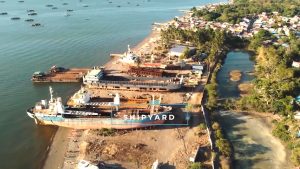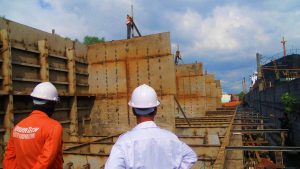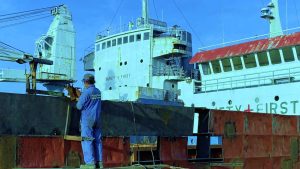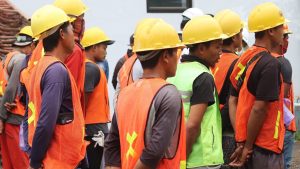Amidst the rhythmic sound of hammers striking metal plates and sparks flying into the night sky, Filipino shipbuilders weave a story of triumph over adversity as they construct LCTs like no other. From humble beginnings to becoming pioneers in this specialized field, these skilled craftsmen merge innovation with tradition, blending modern engineering techniques with age-old wisdom passed down through generations. With each weld laid meticulously, and each bolt tightened strategically, they forge vessels that can withstand even the harshest seas while carrying out life-saving missions. Their dedication to their craft is unrivaled – a true testament to why Filipino shipbuilders are hailed as masters in constructing LCTs efficiently.
Click here to learn about our competencies in constructing LCTs in Tanza, Cavite, Philippines.
Traditional Methods of Constructing LCTs in the Philippines
Traditional Methods of Constructing LCTs in the Philippines have stood the test of time, and Filipino shipbuilders continue to excel at their craft. These skilled craftsmen use a combination of age-old techniques and modern innovations to construct sturdy and efficient landing craft tanks.
One traditional method utilized by Filipino shipbuilders is the use of wooden frames or molds as the foundation for constructing LCTs. These frames are carefully crafted using rich hardwoods like Philippine mahogany, known for its durability. The wooden frame acts as a guide for shaping and aligning the steel plates that form the hull of the vessel. It is remarkable how these craftsmen can seamlessly merge woodwork with metal construction, resulting in a robust final product.
Another striking aspect of traditional LCT construction in the Philippines is the emphasis on handcrafted details. Shipbuilders meticulously carve intricate designs onto wooden panels that adorn various parts of the vessel, such as staircases and railings. This attention to detail brings an aesthetic appeal to every LCT built by these artisans. Additionally, this practice highlights their immense pride in their workmanship, ensuring each ship possesses a unique identity that reflects both tradition and innovation.
The Traditional methods of constructing LCTs in the Philippines offer more than just efficient production; they demonstrate a deep-rooted connection to maritime heritage passed down through generations. By blending old techniques with modern technology, these Filipino shipbuilders continue to create high-quality vessels that stand ready to serve various industries around the world.

Innovations and New Techniques in Constructing LCTs in the Philippines
One of the key innovations in constructing LCTs in the Philippines is the use of advanced welding techniques. Filipino shipbuilders have embraced modern welding technologies, such as gas metal arc welding (GMAW) and flux-cored arc welding (FCAW), to ensure strong and durable joints. These techniques offer improved efficiency, allowing for faster construction times without compromising on quality.
Another notable innovation in LCT construction is the implementation of computer-aided design (CAD) software. Shipbuilding companies in the Philippines now utilize CAD systems to design and simulate various components of LCTs before actual fabrication begins. This not only helps engineers visualize and analyze potential issues but also enables modifications to be made easily at an early stage, minimizing costly rework later on.
Additionally, eco-friendly materials are being introduced into the construction process. For example, some shipyards now opt for composite materials instead of traditional steel for certain sections of LCTs’ structures. Not only are composites lightweight, increasing fuel efficiency, but they also provide better resistance against corrosion and prolong the operational life span of the vessel.
These ongoing innovations and new techniques demonstrate how Filipino shipbuilders are continuously striving for excellence in constructing LCTs. By embracing advanced welding practices, utilizing CAD technology for efficient design processes, and exploring eco-friendly materials, they are ensuring that these vessels meet international standards while improving overall performance and sustainability.

Utilization of Local Materials in Constructing LCTs in the Philippines
One of the notable aspects of Filipino shipbuilders’ efficiency in constructing LCTs (Landing Craft Tanks) is their utilization of local materials. Rather than relying solely on imported components, these shipbuilders have tapped into the rich resources of the Philippines, allowing for a more cost-effective and sustainable construction process.
By using local materials, such as bamboo and coconut wood, Filipino shipbuilders not only support their own economy but also showcase the potential for innovation within their industry. These materials provide excellent structural integrity while also being lightweight, making them ideal for LCT construction. Additionally, the use of locally sourced materials reduces transportation costs and carbon emissions associated with importing building components.
Furthermore, using local resources gives Filipino shipbuilders the advantage of working with familiar materials that they have seen firsthand throughout their lives. This intuitive understanding allows for greater precision in design and construction, resulting in higher-quality LCTs that meet or exceed international standards. It also fosters a sense of cultural pride as traditional Philippine craftsmanship techniques are integrated into modern shipbuilding practices.
In conclusion, the utilization of local materials in constructing LCTs in the Philippines showcases not only ingenuity but also a commitment to sustainability and economic growth. By tapping into homegrown resources and expertise, Filipino shipbuilders are proving themselves as efficient players in the international maritime industry. Their dedication to utilizing local materials serves as an inspiration for other countries looking to embrace sustainable practices while maximizing efficiency in their own manufacturing processes.

Cost-Effective Practices in Constructing LCTs in the Philippines
One of the key factors contributing to the efficient construction of landing craft tanks (LCTs) in the Philippines is the utilization of cost-effective practices. Filipino shipbuilders have successfully implemented several strategies to reduce production costs without compromising on quality.
Firstly, local shipbuilders source materials locally whenever possible, which helps minimize transportation and importation costs. This not only supports local industries but also ensures timely availability of materials, streamlining the construction process.
Additionally, Filipino shipbuilders adopt lean manufacturing principles by optimizing their production processes and eliminating waste. This includes closely monitoring inventory levels, reducing lead times for component delivery, and conducting regular performance audits to identify areas for improvement.
Furthermore, embracing technological advancements has played a crucial role in enhancing cost-effectiveness. Shipbuilders are investing in modern machinery and equipment that streamline operations while reducing labor requirements. Automation technologies are being integrated into various stages of construction, from cutting and shaping steel plates to outfitting cabins.
Ultimately, these cost-effective practices enable Filipino shipbuilders to provide competitive prices for their clients without compromising safety or quality standards. As demand for LCTs increases both domestically and internationally, these efficient construction methods position the Philippines as a leading player in the maritime industry.
The Most Efficient Shipbuilder Company in Constructing LCTs in the Philippines
When it comes to shipbuilding companies in the Philippines that specialize in constructing LCTs, Amaya Dockyard & Marine Services Inc. (ADMSI) stands out as a reliable and efficient choice. With years of experience under their belt, ADMSI has developed cost-effective solutions for clients seeking quality vessels for various purposes. From cargo transportation to military operations, LCTs play a vital role in multiple industries, and ADMSI understands the specific requirements needed to construct these specialized vessels.
- Email us: info@amayadockyard.com
- Call our 24-hour hotline: +63 917 633 0479
- Viber: +63 917 633 0479
- WhatsApp: +63 917 633 0479
- Facebook Messenger: Click here
- Click here to inquire
What sets ADMSI apart from other shipbuilders is its commitment to innovation and excellence. They employ industry professionals who are experts in their fields, working hand-in-hand with clients throughout the construction process. This close collaboration ensures that every LCT built by ADMSI meets client expectations while adhering to international standards for safety and reliability.
Another advantage of choosing ADMSI is its ability to create bespoke designs tailored to each customer’s unique needs. Whether you require modifications for onboard facilities or specific load-bearing capacities, ADMSI can accommodate your requests with precision and expertise. Their attention to detail guarantees that each LCT they construct is fit for purpose, ensuring smooth operations and maximum efficiency once it hits the water.
If you are searching for a shipbuilder company in the Philippines specializing in constructing LCTs, look no further than Amaya Dockyard & Marine Services Inc. With their cost-effective solutions, commitment to excellence, and ability to deliver tailor-made designs, ADMSI is the perfect choice for all your LCT construction needs. Their team of highly skilled engineers and technicians work tirelessly to ensure that every aspect of the vessel meets your exact specifications.

Efficient Project Management Strategies for Timely Delivery of Newly Constructed LCTs
Efficient project management strategies are essential when it comes to the timely delivery of newly constructed LCTs (landing craft tanks). With the demand for these vessels steadily increasing, Filipino shipbuilders have honed their skills in ensuring that projects are completed on schedule. One key strategy is meticulous planning, where every detail and step of the construction process is carefully mapped out. This enables shipbuilders to anticipate possible setbacks or delays and proactively address them. Additionally, effective communication among all stakeholders is crucial to avoid misunderstandings and keep everyone aligned with the project’s timeline.
Another vital aspect of efficient project management in constructing LCTs is resource allocation. Shipbuilders must meticulously assign manpower, materials, and equipment to different phases of construction to optimize productivity. By strategically organizing resources and avoiding bottlenecks, builders can ensure a smooth workflow throughout the entire project duration. Moreover, employing modern technology solutions like automated systems can greatly enhance efficiency in tracking progress and identifying areas for improvement or adjustment.
Filipino shipbuilders understand that efficient project management strategies are vital for the timely delivery of newly constructed LCTs. Through meticulous planning and effective communication, they ensure all tasks are completed as scheduled while actively addressing any potential setbacks. Furthermore, by optimally allocating resources and leveraging technology solutions, they maximize productivity and maintain a smooth workflow throughout the construction process.

Emphasis on Quality and Safety Standards of Constructing LCTs in the Philippines
In the booming industry of shipbuilding in the Philippines, one aspect that stands out is the emphasis on quality and safety standards when it comes to constructing LCTs (Landing Craft Tanks). Filipino shipbuilders understand that these vessels are not only used for transportation but also play a vital role in military operations or humanitarian missions. As a result, they take extra care to ensure that every LCT built complies with international safety regulations.
One of the key factors contributing to the high quality and safety standards is the rigorous training and certification programs provided by local maritime authorities. Shipbuilders undergo extensive training in various aspects, such as welding techniques, structural integrity, stability calculations, and firefighting measures. They are also updated regularly on new developments in shipbuilding technology to ensure their construction practices remain up-to-date.
Additionally, Filipino shipyards have access to top-notch infrastructure and equipment, enabling them to construct LCTs efficiently without compromising on quality or safety. They utilize advanced computer-aided design software during planning stages to simulate various scenarios and identify potential issues in advance. This proactive approach helps prevent any future problems once the vessel is operational.
In conclusion, the emphasis on quality and safety standards when constructing LCTs in the Philippines showcases the commitment of Filipino shipbuilders to delivering reliable vessels that meet international standards. With their extensive training programs, access to modern infrastructure, and utilization of advanced technology throughout every stage of construction – from design to execution – they continue to prove themselves as leaders in this industry.

Skills and Expertise: What Sets Filipino Shipbuilders Apart in Constructing LCTs in the Philippines
Filipino shipbuilders have gained a reputation for their exceptional skills and expertise in constructing LCTs in the Philippines. What sets them apart is their ability to efficiently build these vessels with utmost precision and attention to detail. One key aspect of Filipino shipbuilders’ expertise lies in their understanding of the specific requirements and demands of LCT construction, enabling them to optimize every step of the process.
Another distinguishing factor is the high level of craftsmanship exhibited by Filipino shipbuilders. Their meticulous attention to detail ensures that each component of an LCT is built with precision, resulting in a sturdy and reliable vessel. From welding the steel hulls to installing navigation systems, every task is executed flawlessly. The pride they take in their work shines through in each finished product.
Moreover, Filipino shipbuilders have a deep understanding of maritime regulations and standards required for building LCTs. They are well-versed in safety protocols, environmental considerations, and industry best practices. This knowledge allows them to construct LCTs that not only meet international standards but also exceed expectations when it comes to reliability and performance.
What sets Filipino shipbuilders apart in constructing LCTs is their unique combination of skills, expertise, and dedication demonstrated throughout the construction process. Their ability to adapt quickly to changing requirements, attention to detail, craftsmanship, and adherence to industry regulations ensure that they consistently deliver high-quality vessels that excel in efficiency and reliability on both local and international fronts.

Collaborative Industry: The Power of Partnerships and Networks in Constructing LCTs in the Philippines
Collaboration is the key to success in any industry, and this holds true for the construction of LCTs in the Philippines. In recent years, Filipino shipbuilders have harnessed the power of partnerships and networks to construct these landing craft tanks efficiently. By working together, these companies have been able to leverage each other’s strengths and resources, resulting in a more streamlined and cost-effective production process.
One example of successful collaboration is seen in the joint ventures between local shipyards and international technology providers. These partnerships allow Filipino shipbuilders to tap into advanced technologies and expertise from around the world, enhancing their capacity to construct LCTs with improved efficiency and quality. Moreover, by partnering with international companies, local shipyards gain access to global markets, enabling them to expand their reach beyond domestic customers.
The power of partnerships extends beyond technology transfer; it also encompasses knowledge-sharing among industry players. Shipbuilding associations and networks play a vital role in facilitating this exchange of information. Through forums, conferences, and training programs organized by these organizations, Filipino shipbuilders not only improve their technical skills but also stay updated on best practices in constructing LCTs. This collaborative environment fosters innovation and allows for continuous improvement within the industry as a whole.
Collaborative efforts are transforming the landscape of LCT construction in the Philippines. By leveraging partnerships with international technology providers and actively participating in knowledge-sharing networks within the industry, Filipino shipbuilders are able to construct these landing craft tanks efficiently while maintaining high standards of quality and safety. This has led to an increase in demand for Filipino-built LCTs, both domestically and internationally.

Constructing LCTs with On-Time Delivery for Each Shipbuilding Project in the Philippines
Filipino shipbuilders have been gaining recognition for their efficient construction of Landing Craft Tanks (LCTs) in the Philippines. One key element that sets them apart is their ability to deliver each shipbuilding project on time, regardless of its complexity or size.
This commitment to on-time delivery can be attributed to a combination of factors. Firstly, Filipino shipbuilders prioritize careful planning and effective project management from the very beginning. This ensures that each step of the construction process is well-coordinated and synchronized, minimizing delays and allowing for timely completion.
Additionally, Filipino shipbuilders have honed their skills over years of experience in the industry. Their expertise in constructing LCTs in the Philippines translates into streamlined workflows and optimized processes that contribute to faster turnaround times without compromising quality. This not only satisfies customers’ expectations but also solidifies the Philippines’ reputation as a reliable destination for global shipbuilding projects.
In conclusion, constructing LCTs with on-time delivery has become a hallmark of Filipino shipbuilders operating in the Philippines. Through meticulous planning, effective project management, and extensive expertise, they continue to impress clients around the world with their ability to meet deadlines while delivering high-quality vessels. As demand for LCTs grows globally, it is clear that Filipino shipbuilders are well-equipped and positioned to take advantage of this trend by consistently exceeding customer expectations through timely completions.

The Importance of LCTs in the Philippine Maritime Industry
Landing Craft Tanks (LCTs) play a vital role in the Philippine maritime industry, particularly in supporting the country’s economic growth and national defense. These versatile vessels are specifically designed to transport heavy equipment, vehicles, and cargo from larger ships directly to shore. The importance of LCTs lies in their ability to navigate shallow waters and reach locations that may be inaccessible to traditional cargo vessels.
One key advantage of LCTs is their efficiency in delivering goods and supplies to remote islands, coastal areas, or areas affected by natural disasters. By employing LCTs, the logistical challenges associated with these regions can be effectively resolved. Moreover, these vessels provide essential support for infrastructure development projects such as port construction, offshore drilling operations, and tourism initiatives.
Furthermore, the utilization of LCTs enhances the capability and readiness of the Philippine Navy during times of conflict or humanitarian crises. With its capacity to transport troops and equipment directly onto unprepared coastlines quickly, LCTs play a critical role in responding promptly to security threats or disaster relief efforts. In this sense, they contribute significantly towards bolstering national defense capabilities while also serving as versatile tools for peacekeeping missions within Southeast Asia.
The importance of LCTs in the Philippine maritime industry cannot be overstated. Their unique functionality allows for efficient transportation of goods and supplies to remote areas while providing valuable support for infrastructural development projects. Additionally, these vessels enhance both security capabilities and disaster-response efforts when faced with military conflicts or natural calamities.

Filipino Shipbuilding Industry Overview: The Art of Constructing LCTs
The Filipino shipbuilding industry has been making waves in recent years, especially when it comes to the construction of Landing Craft Tanks (LCTs). These vessels play a crucial role in military operations, as they are designed to transport tanks and other heavy equipment directly onto enemy shores. The art of constructing LCTs requires not only skilled craftsmanship but also a deep understanding of naval engineering.
Filipino shipbuilders have proven themselves to be masters of this craft. They have honed their skills over generations, combining traditional techniques with modern advancements in shipbuilding technology. This unique blend allows them to construct LCTs efficiently and effectively, meeting the demands of both domestic and international markets.
Furthermore, what sets Filipino shipbuilders apart is their attention to detail and commitment to delivering quality vessels. Each LCT is meticulously crafted and undergoes rigorous testing to ensure that it meets international standards for safety and performance. This dedication to excellence has earned the trust of clients worldwide, boosting the reputation of the Filipino shipbuilding industry on a global scale.
The Filipino shipbuilding industry’s prowess in constructing LCTs showcases its remarkable ability to balance tradition with innovation. Their mastery of this craft stems from generations’ worth of experience and expertise passed down through time. With an unwavering commitment to quality control and emphasis on precision, these talented shipbuilders continue to make significant contributions not only towards economic growth but also in shaping the future landscape of maritime defense technology.

Filipino Shipbuilders are Leading the Way in Constructing LCTs Efficiently
With their exceptional craftsmanship and commitment to delivering high-quality vessels, Filipino shipbuilders are making a name for themselves in the global maritime industry. In particular, they have been leading the way in constructing Landing Craft Tanks (LCTs) efficiently. LCTs play a vital role in military operations and transporting heavy equipment, so it is crucial to build them with precision and durability.
One reason why Filipino shipbuilders excel in constructing LCTs efficiently is their expertise in optimizing space utilization. By carefully planning the layout of each vessel, they ensure maximum efficiency without compromising safety or functionality. This expertise allows them to build LCTs that can accommodate large cargos without sacrificing maneuverability or stability.
Additionally, Filipino shipbuilders are capitalizing on advanced technologies like computer-aided design (CAD) systems and digital simulation tools. These technologies enable more accurate modeling and prediction of vessel performance, which results in fewer errors during construction. By embracing these cutting-edge tools, Filipino shipbuilders can streamline their processes and reduce waste while still meeting stringent quality standards.
In conclusion, it is evident that Filipino shipbuilders are at the forefront of efficiently constructing LCTs. Their mastery of space utilization combined with their utilization of advanced technologies has paved the way for enhanced productivity and exceptional craftsmanship. As they continue to showcase their skills on a global scale, it is no wonder that Filipino shipbuilders remain highly sought after by both domestic and international clients, seeking reliable ships that deliver utmost performance at competitive prices.

Summary: Filipino Shipbuilders Constructing LCTs Efficiently
Filipino shipbuilders have emerged as global leaders in constructing Landing Craft Tanks (LCTs) efficiently, showcasing their expertise and commitment to excellence in the maritime industry. With a combination of skilled labor and advanced technology, these shipbuilders have successfully overcome challenges and are setting new standards for efficiency.
One key factor contributing to the efficiency of Filipino shipbuilders is their ability to leverage local resources effectively. The Philippines has an abundance of skilled workers who possess extensive knowledge and experience in shipbuilding. This allows for smoother coordination among the various teams involved in the construction process, resulting in faster turnaround times and reduced costs.
Additionally, Filipino shipbuilders prioritize innovation and continuous improvement. They consistently seek ways to enhance design processes, streamline production methods, and incorporate cutting-edge technologies into LCT construction. By investing in research and development, they stay at the forefront of industry trends and deliver vessels that meet stringent international standards.
As a result of these efforts, Filipino shipbuilders not only meet but often exceed customer expectations when it comes to constructing LCTs efficiently. Their dedication to delivering quality vessels on time has positioned them as trusted partners for both domestic and international clients. With their impeccable track record combined with ongoing advancements within the industry, it’s no surprise that Filipino shipbuilders continue to thrive as efficient builders of LCTs.
